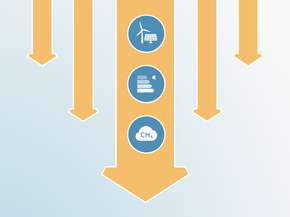Country summary
Overview
New Zealand’s Ardern government elected in 2017 has declared climate action as one of its priorities, and is developing a “Zero Carbon Act” for adoption in 2019 and aims to strengthen the nation’s 2050 target to achieve a form of carbon neutrality by mid-century. The Zero Carbon Act will establish a new Climate Commission to oversee a five year carbon budgeting process to drive the required emission reductions, and is in the process of consultations to tighten up the Emissions Trading Scheme (ETS). The Parliament has also recently passed a bill banning new offshore oil and gas exploration. These processes however mean that there will still be a substantial delay, possibly until 2020, before any new and substantive policies are introduced to actually change the present “Highly insufficient” trajectory of New Zealand’s emissions.
New Zealand’s latest current policy projections are “Highly insufficient” and show total GHG emissions (excl. LULUCF) stabilising at around current levels, about 15% above 1990 levels— this is far from its already “Insufficient” Paris Agreement target, which would require GHG emissions excl. LULUCF to decrease to at least 5% below 1990 levels. Prime Minister Jacinda Ardern has signalled a readiness for NZ to increase its 2030 Paris Agreement NDC target by 2020, however an official announcement has yet to be made.
With the Paris Agreement rule book under negotiation concerns are increasing that New Zealand is positioning to carryover surplus emission units beyond 2020 from its internal application of Kyoto Protocol Second Commitment period accounting rules to meet its 2030 NDC target. The volume of units that would be potentially available if such carryover were allowed could be used to permit NZ GHG emissions incl. LULUCF to rise above 2005 levels.
New Zealand’s Paris Agreement-NDC target—of a 30% reduction from 2005 levels by 2030— is rated as “Insufficient,” meaning that it is not consistent with holding warming to below 2°C, let alone limiting it to 1.5°C as required under the Paris Agreement, and is instead consistent with warming between 2°C and 3°C.
An independent Productivity Commission, tasked to look at how New Zealand can transition to a lower net emissions economy, has issued a report that sets out a range of options across the economy, and recommends improved carbon pricing by reforming the ETS. However, it is too early to quantify the potential impact of the suggested policies on emissions projections. The report confirms that until now, there have been few policies to reduce emissions (an issue pointed out in past CAT assessments) and that delaying action further will compound the transition challenge.
The Productivity Commission has also confirmed the expected emissions levels under current policies are far from the government’s emissions targets for both 2020 and 2030, when looking at national performance alone. However, the New Zealand government is also banking on making use of international units and a certain amount of “creative accounting” to make up the difference. New Zealand has not yet defined what accounting rules it will use, and therefore the legal basis on which is it seeking to rely on its nominated accounting rules is unclear, along with its use of international and LULUCF credits. See pledges and targets section for a full analysis of the targets and LULUCF.
The Productivity Commission concludes that meeting New Zealand’s 2030 Paris Agreement target will be highly challenging, even with immediate and strong action to reduce domestic emissions. International offsets can play a part in meeting this commitment, but any delay in domestic reductions will make future commitments even more difficult to achieve (Carbon Pulse, 2018).
New Zealand’s “Kyoto forests”—largely exotic pine plantations planted in the early 1990s—are due to be harvested in the next few years. This will result in a massive reduction in the carbon sink of 20 MtCO2e/year between 2015 and 2030. This stands in strong contrast with the least-cost mitigation scenarios modelled by the Productivity Commission, which would require the LULUCF sector to increase the sink by between -25 to -50 MtCO2e/year by 2050. The Government has a new policy of planting one billion trees by 2030, but it is unclear as to the planned mix between exotic trees and permanent indigenous forests, adding further uncertainty to projections.
Further analysis
Latest publications
Stay informed
Subscribe to our newsletter




